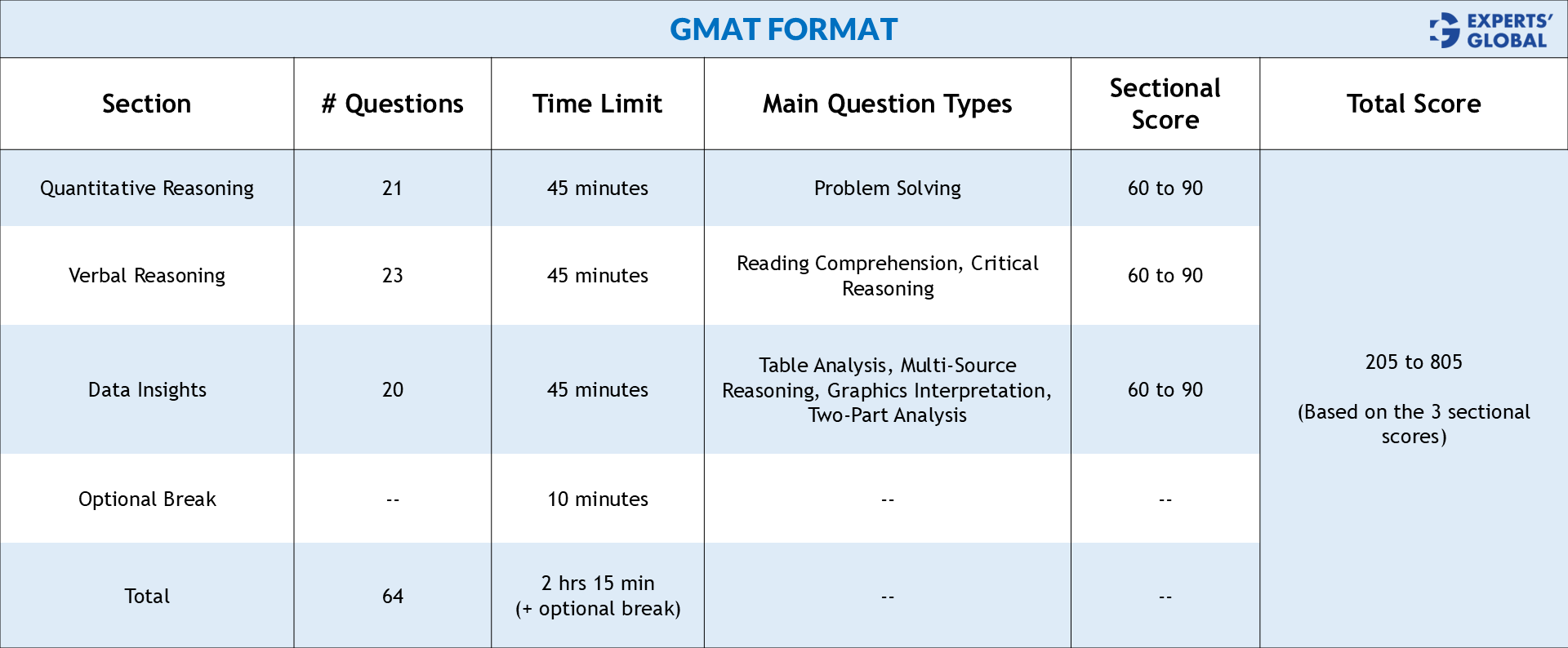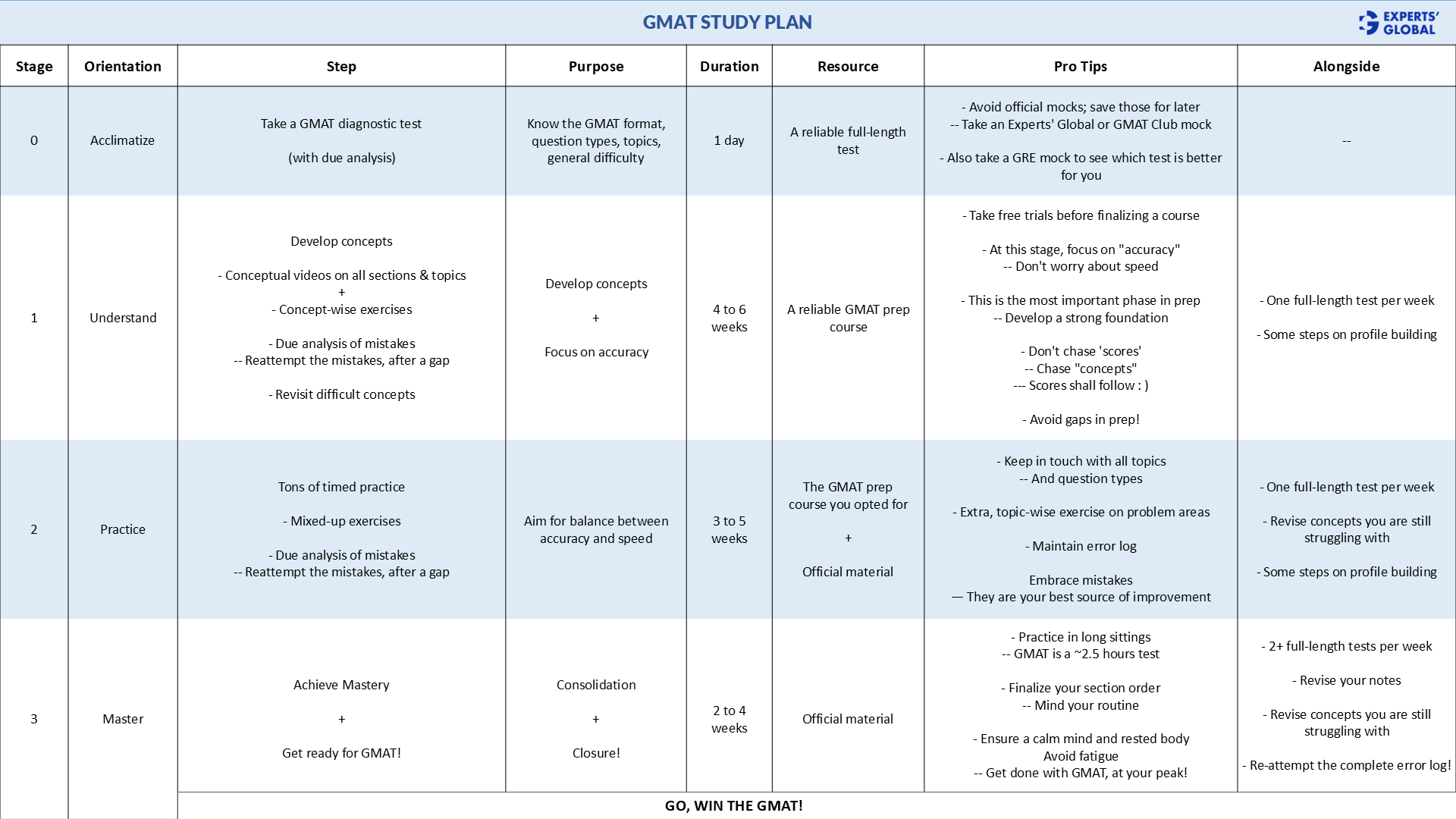Invest 30 seconds...
...for what may lead to a life altering association!
Help Line
- +91.8800.2828.00 (IND)
- 1030-1830 Hrs IST, Mon-Sat
- support@expertsglobal.com
...for what may lead to a life altering association!


Soon after understanding the GMAT format, timing, question types, and interface, attempt a full-length mock test under realistic conditions. Just a few hours of familiarization are sufficient. Take your first mock within the opening week, then space out later mocks naturally as your prep progresses.
Let us now explore the complete picture…
The first full-length GMAT mock is advised to be taken very early to help you set your honest baseline score. Therefore, simply spend a few hours understanding how the GMAT works and take your first mock. You do not need to wait for weeks of preparation; in one focused sitting or a few small sittings, learn about the exam format, test sections, time limits, question types, exam rules etc. Review the on-screen layout and try a few sample questions just to become familiar with navigation and tools. Your first practice test should help you experience the complete GMAT environment and understand your natural starting point. Do not overprepare before this stage – the aim at this stage is to gain comfort with the test’s flow, not to demonstrate content mastery. This short familiarization ensures that your initial score reflects your reasoning and pacing skills, giving you a reliable baseline for your GMAT preparation.

Taking your first practice test early removes guesswork. A test in the first week shows your current level, how timing feels across sections, and where weaknesses lie. It also prevents effort in low-leverage areas. The first score is not a label. It is a starting point that turns hopes into a plan. When you see patterns early, you can choose the right mix of concept study, practice sets, and pacing drills. An early baseline also reduces anxiety later because you will watch trends form over time, not base your plan on a single late score. Further GMAT mock tests are to be spread organically with your prep and target GMAT date.
Please note that your baseline score is only a starting point and not an indication of your eventual score. There is no ceiling to the upside; we see students move from 5th percentiles to the 100th. Treat the baseline as a neutral marker to set where you begin, so you can plan the next phase of preparation carefully and smartly. Use it to map priorities and actions, not to judge your ability or limit your goals.
Your first practice test should reflect your genuine starting level to help you plan your GMAT prep. If you begin taking practice tests without first understanding the test’s format, sections, question types, timing, and on-screen tools, your score may fall for reasons unrelated to your actual ability. Unfamiliarity can slow you down, lead to small mistakes, and distort the meaning of your result. We must distinguish between lack of familiarity and actual skill, so your baseline becomes accurate and meaningful. Spend some time understanding how the test functions, how questions are presented, how pacing feels, and how features such as flag and return work. Then take your first full-length test in a proper GMAT-like setting to gain a genuine baseline score and a clearer direction for your preparation.
If your first practice test score is lower than you hoped, do not feel discouraged. You are only starting out, and early improvement can be rapid. As you grow comfortable with the test format, question types, and key concepts, your score will naturally rise. If your initial performance is stronger than expected, stay balanced. Building further from a good start still needs consistent and focused effort. In either case, treat your first score as what it truly is, a baseline to help you begin your GMAT preparation in an organized and structured way.
Once you have understood the GMAT format and taken your first full-length practice test, you will have a clear picture of the test’s expectations. If you began with an Experts’ Global GMAT mock, your score report includes total and sectional scores with percentiles, performance across question types and topics, time management data, difficulty-wise accuracy, and your five strongest and five weakest areas in each section. Now is the time to plan your preparation by aligning your study schedule with your target score and application deadlines. Balance weekday and weekend study hours, keeping in mind your existing strengths, learning preferences, available resources or mentors, test frequency, and professional or personal commitments. This clarity helps you build a focused and achievable plan for consistent progress.

Take every practice under conditions that match the real exam. Sit at the same time of day you plan to test. Use a quiet room, a proper desk, and the allowed scratch notes. Follow the exact break structure. Respect calculator rules that apply. If your platform allows flag and return (as Experts’ Global’s mocks and official mocks do), use it as you would on test day. Consistent simulation turns nerves into routine and saves mental energy for reasoning.
In the early stage, schedule a full practice test every one to two weeks. Choose a two-week gap if your fundamentals still need reinforcement, and shift to a weekly test once your study rhythm feels steady. The time between tests is where most learning occurs. Use it to review your analytics and correct the patterns highlighted in earlier attempts. During final weeks before your actual GMAT, increase your frequency of mocks and ensure that your review quality remains consistent. Allow recovery time after each mock so that every new study phase begins with clarity and focus.
Adopt a simple loop: test, analyze, repair, and reinforce. After each test, dig into the errors and the near misses. Rework the questions you missed. Practice small sets on your weak patterns. Drill timing on question types that slow you down. Then confirm improvements with a short section practice before the next full test. This cycle compounds gains and keeps effort focused.
First pass: record scores, section breakdowns, and timing summaries without judgment. Second pass: study every miss, every guess, and every lucky quick win. Write the reason, the fix, and the cue you will look for next time. Third pass: extract patterns across questions and design your next week’s plan. End with a short list of high-leverage actions, not a long list you will never finish.
Track more than the total score. Watch accuracy by topic, average time on correct and incorrect answers, number of guesses, and where time pressure spiked. Note careless slips separately from genuine knowledge gaps. Keep a simple log after each test. Trends will appear within three or four tests, and those trends will tell you exactly what to practice.
Choose one or two focus areas for the week. Study concepts, learn step-by-step methods, and practice small targeted sets. Create short checklists for the mistakes you make often. Use spaced repetition for formulas, patterns, and data moves you want to recall fast. End each week by retesting the same skills in mixed sets so the learning holds under pressure.
During the last few weeks before the GMAT, increase the frequency of your mocks. There is no exact frequency that works for every student. Some students prefer taking one or two mocks per week during the last few weeks of their preparation, while some prefer taking a mock almost every day. See what works best for you. What truly matters is that you carefully analyze the analytics after each mock. Take your learnings seriously and review every question that you get incorrect. A mock is worth taking only if you spend enough time analyzing it and learning from your mistakes.
Extra tests without deep analysis create noise. If scores dip, resist the urge to take another test the next day. Instead, review with care, rebuild a few skills, and confirm progress through focused practice. Keep your plan calm and deliberate. Sustainable effort leads to stable results.
The official GMAT mock tests use retired GMAT questions and the original scoring algorithm, making them the most accurate representation of the real exam. However, they are few in number and lack detailed analytics or in-depth explanations. They are best used closer to your actual test date. While taking official tests early is acceptable, it is usually better to save those for later and opt for a dependable third-party GMAT mock for earlier parts of your prep. Ensure that the third-party mock test series you choose comes from a trusted source and is a complete GMAT-like test, since many third-party tools provide shorter quizzes and label them as GMAT mocks.
Creating high-quality GMAT mock tests requires deep expertise. Every element, from question quality, topic coverage, and difficulty balance to scoring accuracy, interface design, and performance analytics, must work together seamlessly to produce meaningful practice. Only a few organizations worldwide develop GMAT mocks that genuinely reflect the real exam. Along with the official GMAT practice tests, depend on one carefully designed third-party test series. This combination ensures dependable performance feedback and a preparation experience that closely resembles the actual GMAT.
If you are beginning your GMAT preparation and have not yet decided which exam to take, it is a good idea to take one of the GRE mock tests as well. Doing so will help you determine which test feels more natural and suits your test-taking style better. Since most business management programs accept both GMAT and GRE scores, your decision should depend on which test you are likely to perform better at based on an informed comparison. You can take a free, full-length GRE diagnostic test through this page to experience the format, timing, and question styles firsthand and gain clarity on which exam aligns best with your strengths and preparation approach.
Practice tests are more than scoreboards. They are weekly meetings with your future self. Each test asks: Did you prepare with care, act with discipline, and learn from your missteps. This habit mirrors business school applications – targets matter, but habits decide outcomes. Plan with intent, execute with honesty, review without excuses, and improve one detail at a time. Progress rarely moves in a straight line, yet steady systems bring reliable growth. Treat every test as a rehearsal for responsible action. You will step into the exam ready, and you will step into your MBA with the same steady mind.